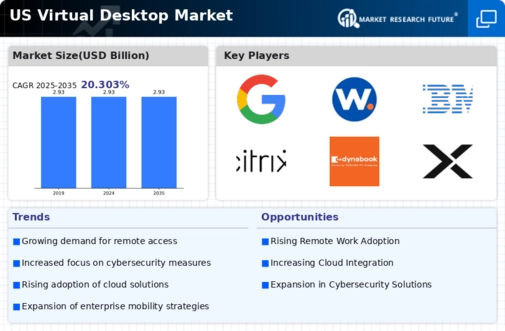The US Virtual Desktop Market has witnessed significant growth and dynamic changes in recent years, driven by an increase in remote work demands, the shift towards cloud-based solutions, and the need for flexible IT infrastructure. As businesses seek to optimize their operations while ensuring data security, numerous players have entered the virtual desktop arena, creating a competitive landscape that is characterized by innovation and differentiation. Companies are consistently evolving their offerings to include enhanced performance, security features, and user-friendly interfaces, aimed at catering to a diverse range of industries and customer needs.
The competitive insights reveal that successful entities not only focus on technology but also emphasize customer support, scalability, and integration capabilities with existing IT environments. In the context of the US Virtual Desktop Market, VMware stands out with its robust offerings and significant market presence. Known for pioneering virtualization technology, VMware has leveraged its extensive portfolio to deliver innovative solutions that enhance cloud infrastructure and digital workspaces. The company excels in providing reliable and scalable virtual desktop solutions, which allow enterprises to manage and deploy desktops and applications efficiently.
VMware's strengths lie in its strong emphasis on security, ease of deployment, and integration capabilities with hybrid cloud environments. Its ability to cater to a variety of business sizes and industries, paired with strategic partnerships and a commitment to continuous innovation, solidifies VMware's position as a leader in the US virtual desktop market. On the other hand, Google has made notable strides in the US Virtual Desktop Market, leveraging its significant technological expertise and cloud infrastructure.
Google's key offerings in this space include its Workspace product suite, which integrates applications with cloud-based desktop solutions, enabling seamless collaboration and productivity for remote teams. The advantages of Google's virtual desktop solutions include ease of use, high security standards, and the backing of its global cloud architecture. The company has also pursued strategic mergers and acquisitions to bolster its capabilities in this sector, enhancing its technological offering and market reach.
By focusing on improving user experience and performance while promoting collaboration and data security, Google continues to strengthen its position and capitalize on emerging trends in the US virtual desktop landscape.





















Leave a Comment